Optimal Design for 3-PSS Flexible Parallel Micromanipulator Based on Kinematic and Dynamic Characteristics
Abstract
:1. Introduction
2. Kinematics and Dynamics Performance Analysis
2.1. Kinematics Analysis of 3-PSS Flexible Parallel Micromanipulator
2.1.1. Workspace Analysis of 3-PSS Flexible Parallel Micromanipulator
2.1.2. Dexterity Analysis of 3-PSS Flexible Parallel Micromanipulator
2.2. Dynamics Analysis of 3-PSS Flexible Parallel Micromanipulator
3. Progressive Optimal Design Based on Kinematics and Dynamics
3.1. The Scale Parameters Optimization Based on Kinematic Performance
3.2. Optimization of Flexure Spherical Hinge Structure Parameters Based on Dynamic Performance
4. Synchronous Optimal Design Based on Kinematics and Dynamics
5. Conclusions
Author Contributions
Funding
Institutional Review Board Statement
Informed Consent Statement
Data Availability Statement
Conflicts of Interest
Appendix A. The Scale Parameters of Micromanipulator, Kinematic, and Dynamic Performance of 3-PSS Flexible Parallel Micromanipulator after Optimization with Different Inscribed Circle Radius as Constraints
| Parameters | After Optimization | |||
|---|---|---|---|---|
| Inscribed circle radius (μm) | 100 | 200 | 300 | 500 |
| Scale parameters (mm) | l = 50, ra = 60.3 | l = 50, ra = 46.82 | l = 50, ra = 40.53 | l = 50, ra = 62.22 |
| Volume of workspace | ↓ 67.46% | ↓ 33.27% | ↓ 1.03% | ↑ 62.22% |
| Global dexterity | 0.7045 | 0.3428 | 0.2309 | 0.1408 |
| Natural frequency (Hz) | 77.25 | 74.29 | 73.80 | 73.95 |
References
- Howell, L.L. Compliant Mechanisms; McCarthy, J.M., Ed.; Springer: London, UK, 2012; pp. 189–216. [Google Scholar]
- Speich, J.; Goldfarb, M. A Compliant-Mechanism-Based Three Degree-of-Freedom Manipulator for Small-Scale Manipulation. Robotica 2000, 18, 95–104. [Google Scholar] [CrossRef]
- Kota, S.; Hetrick, J.; Li, Z.; Saggere, L. Tailoring Unconventional Actuators Using Compliant Transmissions: Design Methods and Applications. IEEE/ASME Trans. Mechatron. 1999, 4, 396–408. [Google Scholar] [CrossRef]
- Tian, Y.; Shirinzadeh, B.; Zhang, D.; Alici, G. Development and Dynamic Modelling of a Flexure-Based Scott-Russell Mechanism for Nano-Manipulation. Mech. Syst. Signal Process. 2009, 23, 957–978. [Google Scholar] [CrossRef]
- Zubir, M.N.M.; Shirinzadeh, B.; Tian, Y. A New Design of Piezoelectric Driven Compliant-Based Microgripper for Micromanipulation. Mech. Mach. Theory 2009, 44, 2248–2264. [Google Scholar] [CrossRef]
- Fattah, A.; Angeles, J.; Misra, A.K. Dynamics of a 3-DOF Spatial Parallel Manipulator with Flexible Links. In Proceedings of the 1995 IEEE International Conference on Robotics and Automation, Nagoya, Japan, 21–27 May 1995; pp. 627–633. [Google Scholar]
- Hao, F.; Merlet, J.P. Multi-Criteria Optimal Design of Parallel Manipulators Based on Interval Analysis. Mech. Mach. Theory 2004, 40, 157–171. [Google Scholar] [CrossRef]
- Ren, J.; Li, Q. Analysis of Compliance and Kinetostatic of a Novel Class of n-4R Compliant Parallel Micro Pointing Mechanism. Micromachines 2022, 13, 1014. [Google Scholar] [CrossRef]
- Li, C.; Wang, J.; Chen, S. Flexure-Based Dynamic-Tunable Five-Axis Nanopositioner for Parallel Nanomanufacturing. Precis. Eng. 2016, 45, 423–434. [Google Scholar] [CrossRef]
- Berna, Ö.; Raquel, P.; Ahmet, B.; Lucio, P.; Ece, Ö.; Claire, A.; Murat, K.; Francesco, S.; Mooney, D.J.; Selman, S.M. Modular Soft Robotic Microdevices for Dexterous Biomanipulation. Lab Chip 2019, 19, 778–788. [Google Scholar]
- Dsouza, R.D.; Navin, K.P.; Theodoridis, T.; Sharma, P. Design, Fabrication and Testing of a 2 DOF Compliant Flexural Microgripper. Microsyst. Technol. 2018, 24, 3867–3883. [Google Scholar] [CrossRef]
- Giamberardino, P.D.; Bagolini, A.; Bellutti, P.; Rudas, I.J.; Verotti, M.; Botta, F.; Belfiore, N.P. New MEMS Tweezers for the Viscoelastic Characterization of Soft Materials at the Microscale. Micromachines 2017, 9, 15. [Google Scholar] [CrossRef]
- Shao, Z.; Tang, X.; Wang, L.; Sun, D. Atlas based kinematic optimum design of the Stewart parallel manipulator. Chin. J. Mech. Eng. 2015, 28, 20–28. [Google Scholar] [CrossRef]
- Staicu, S.; Zhang, D. Dynamic modelling of a 4-DOF parallel kinematic machine with revolute actuators. Int. J. Manuf. Res. 2008, 3, 172–187. [Google Scholar]
- Ding, B.; Li, Y.; Xiao, X.; Tang, Y.; Li, B. Design and analysis of a 3-DOF planar micromanipulation stage with large rotational displacement for micromanipulation system. Mech. Sci. 2017, 8, 117–126. [Google Scholar] [CrossRef]
- Lu, S.; Li, Y.; Ding, B. Kinematics and dynamics analysis of the 3PUS-PRU parallel mechanism module designed for a novel 6-DOF gantry hybrid machine tool. J. Mech. Sci. Technol. 2020, 34, 345–357. [Google Scholar] [CrossRef]
- Yu, J.; Zhou, Q.; Bi, S.; Zong, G. Optimal Design of a Fully Compliant Mechanism Based on Its Dynamic Characteristics. Chin. J. Mech. Eng. 2003, 39, 32–36. [Google Scholar] [CrossRef]
- He, J.; Li, J.; Sun, Z.; Gao, F.; Wu, Y.; Wang, Z. Kinematic design of a serial-parallel hybrid finger mechanism actuated by twisted-and-coiled polymer. Mech. Mach. Theory 2020, 152, 103951. [Google Scholar] [CrossRef]
- Ding, B.; Li, X.; Li, Y. FEA-based optimization and experimental verification of a typical flexure-based constant force module. Sens. Actuators A Phys. 2021, 332, 113083. [Google Scholar] [CrossRef]
- Yang, M.; Du, Z.; Sun, L.; Dong, W. Optimal design, modeling and control of a long stroke 3-PRR compliant parallel manipulator with variable thickness flexure pivots. Robot. Comput.—Integr. Manuf. 2019, 60, 23–33. [Google Scholar]
- Xu, K.; Liu, H.; Yue, W.; Xiao, J.; Ding, Y.; Wang, G. Kinematic modeling and optimal design of a partially compliant four-bar linkage using elliptic integral solution. Mech. Mach. Theory 2021, 157, 104214. [Google Scholar] [CrossRef]
- Li, Y.; Xu, Q. A novel design and analysis of a 2-DOF compliant parallel micromanipulator for nanomanipulation. IEEE Trans. Autom. Sci. Eng. 2006, 3, 247–254. [Google Scholar]
- Li, Y.; Xu, Q. Design and Optimization of an XYZ Parallel Micromanipulator with Flexure Hinges. J. Intell. Robot. Syst. 2009, 55, 377–402. [Google Scholar] [CrossRef]
- Xu, Q.; Li, Y. Kinematic Analysis and Optimization of a New Compliant Parallel Micromanipulator. Int. J. Adv. Robot. Syst. 2006, 3, 47. [Google Scholar] [CrossRef]
- Jia, X.; Zhang, D.; Tian, Y. Workspace Analysis and Optimization of a 3-DOF Precision Positioning Table. Acta Armamentarii 2010, 31, 624–630. [Google Scholar]
- Wang, W.; Zhang, L.; Bi, S. Dynamic Analysis and Design of Compliant Mechanisms Using the Finite Element Method. Appl. Mech. Mater. 2012, 163, 111–115. [Google Scholar] [CrossRef]
- Li, H.; Yang, Z.; Huang, T. Dynamics and elasto-dynamics optimization of a 2-DOF planar parallel pick-and-place robot with flexible links. Struct. Multidiscip. Optim. 2009, 38, 195–204. [Google Scholar] [CrossRef]
- Du, Z.; Yu, Y.; Su, L. Effects of Inertia Parameters of Moving Platform on the Dynamic Characteristic of Flexible Parallel Mechanism and Optimal Design. Opt. Precis. Eng. 2006, 14, 1009–1016. [Google Scholar] [CrossRef]
- Li, Y.; Xu, Q. Design and Analysis of a Totally Decoupled Flexure-Based XY Parallel Micromanipulator. IEEE Trans. Robot. 2009, 25, 645–657. [Google Scholar]
- Li, Y.; Huang, J.; Tang, H. A Compliant Parallel XY Micromotion Stage with Complete Kinematic Decoupling. IEEE Trans. Autom. Sci. Eng. 2012, 9, 538–553. [Google Scholar] [CrossRef]
- Ren, J.; Cao, Q. Dynamic Modeling and Frequency Characteristic Analysis of a Novel 3-PSS Flexible Parallel Micro-Manipulator. Micromachines 2021, 12, 678. [Google Scholar] [CrossRef]
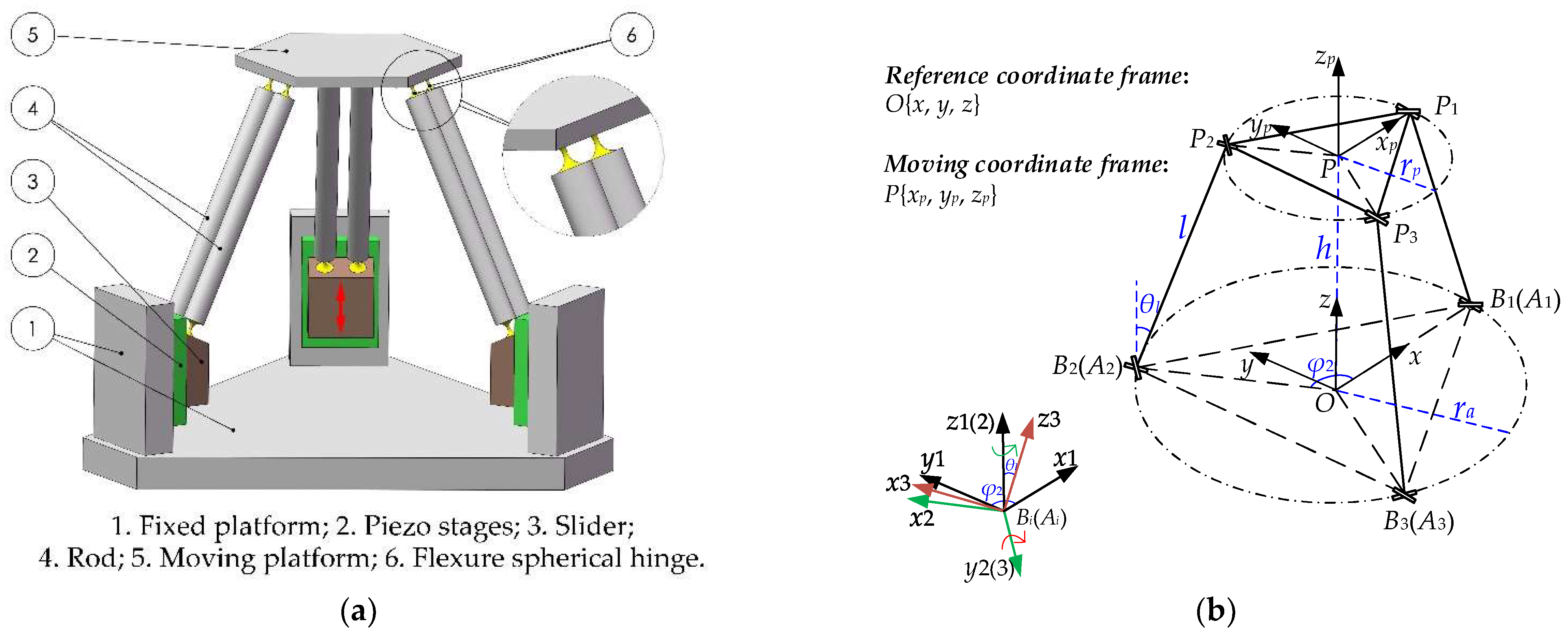
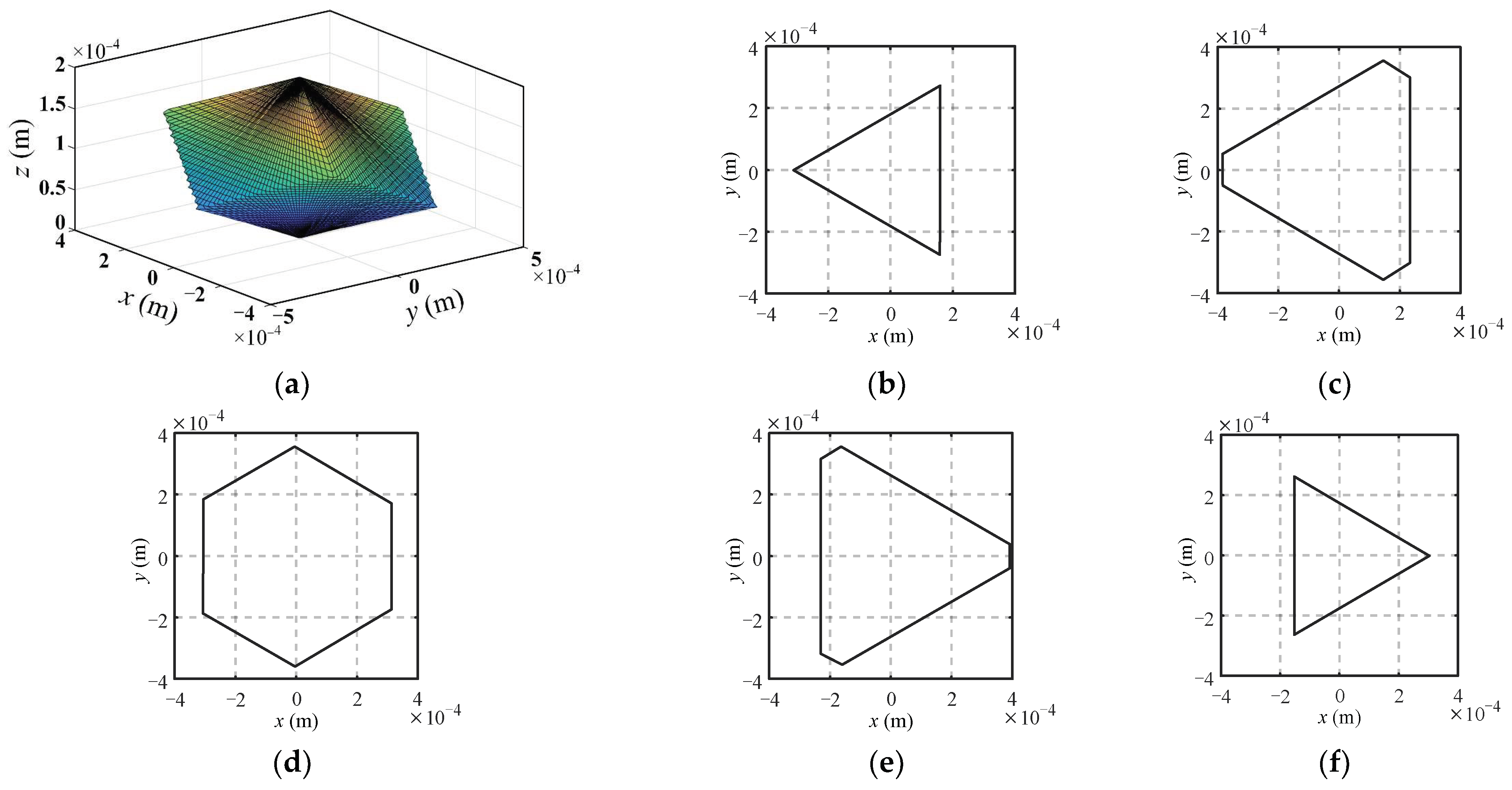
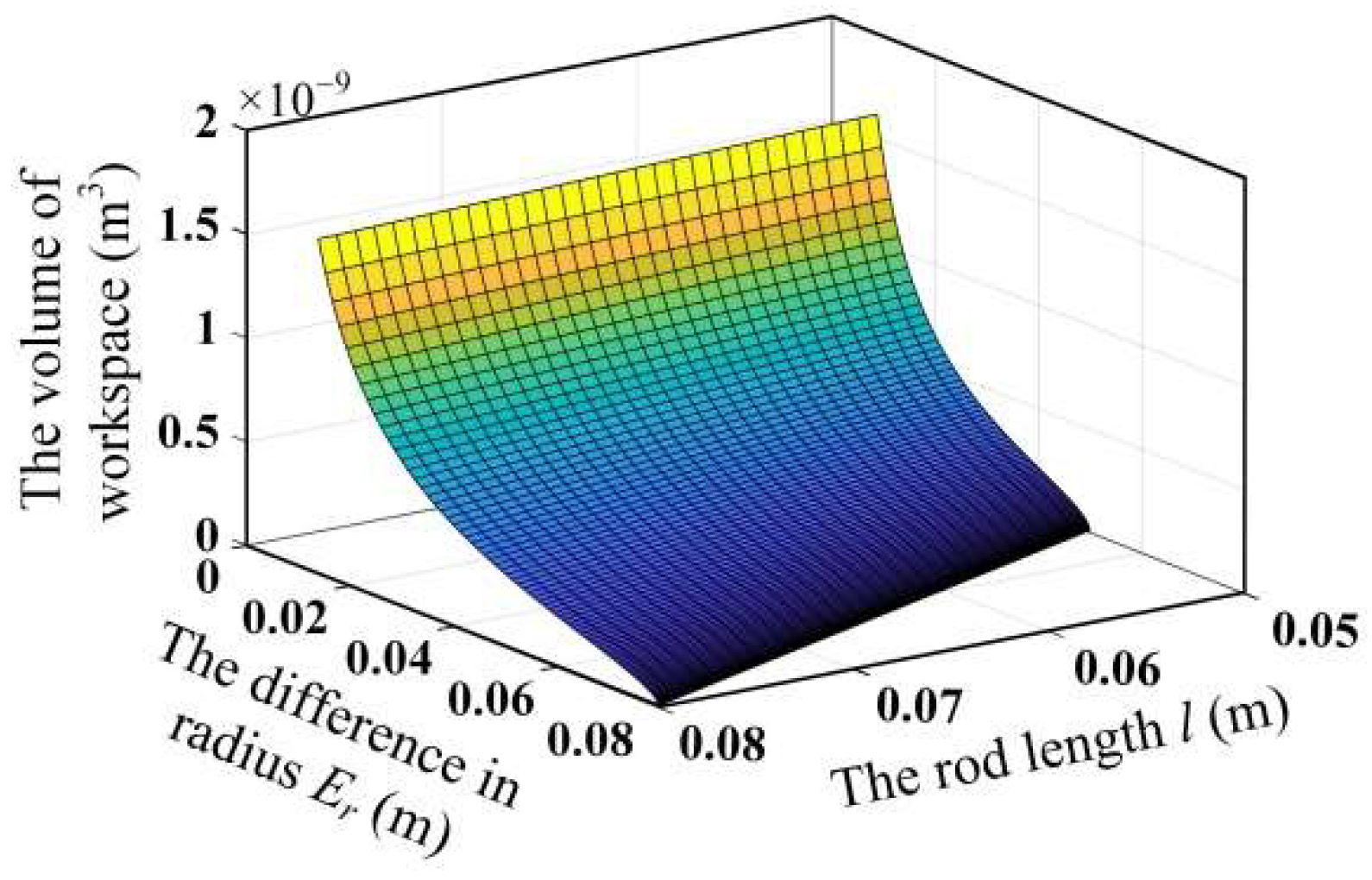
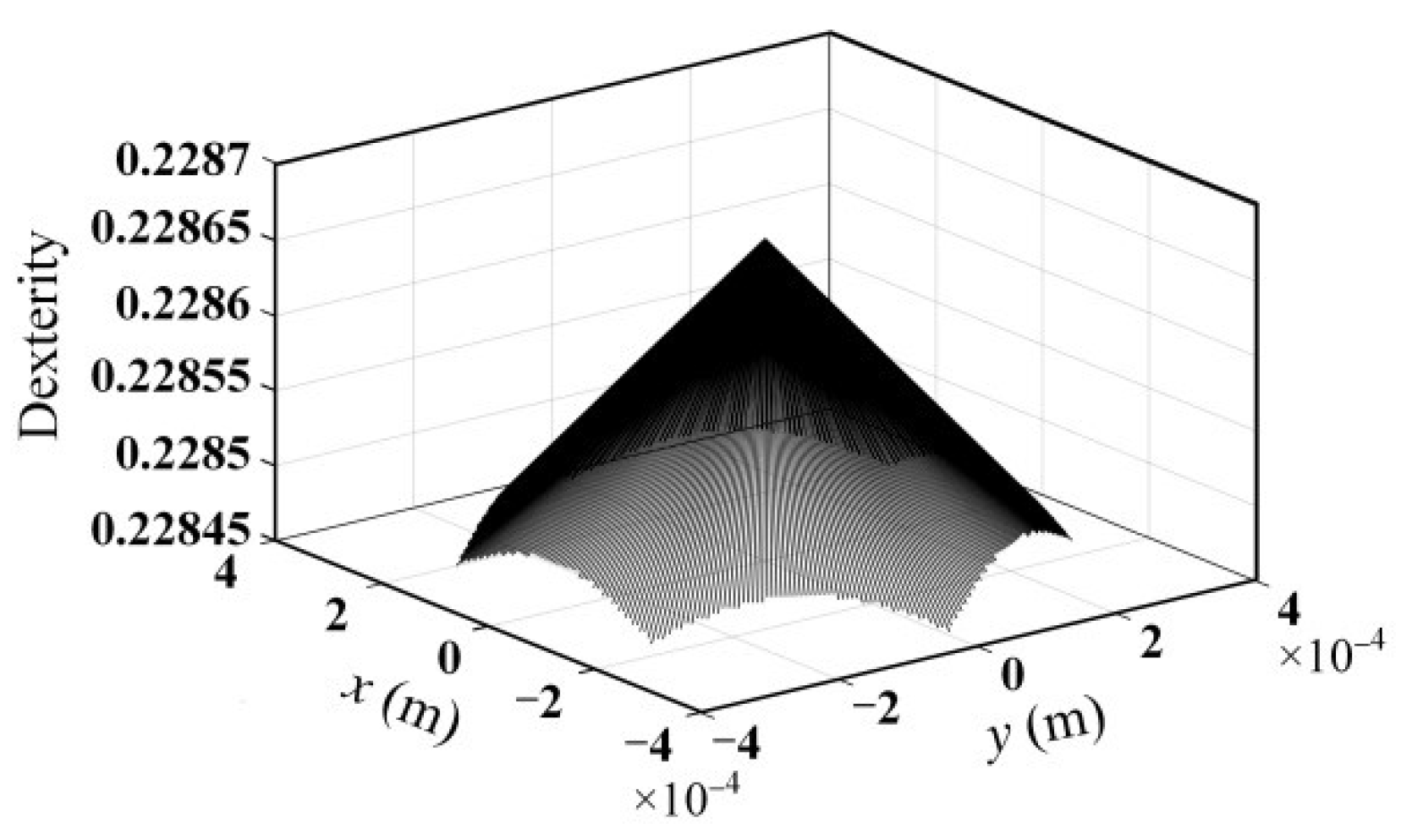
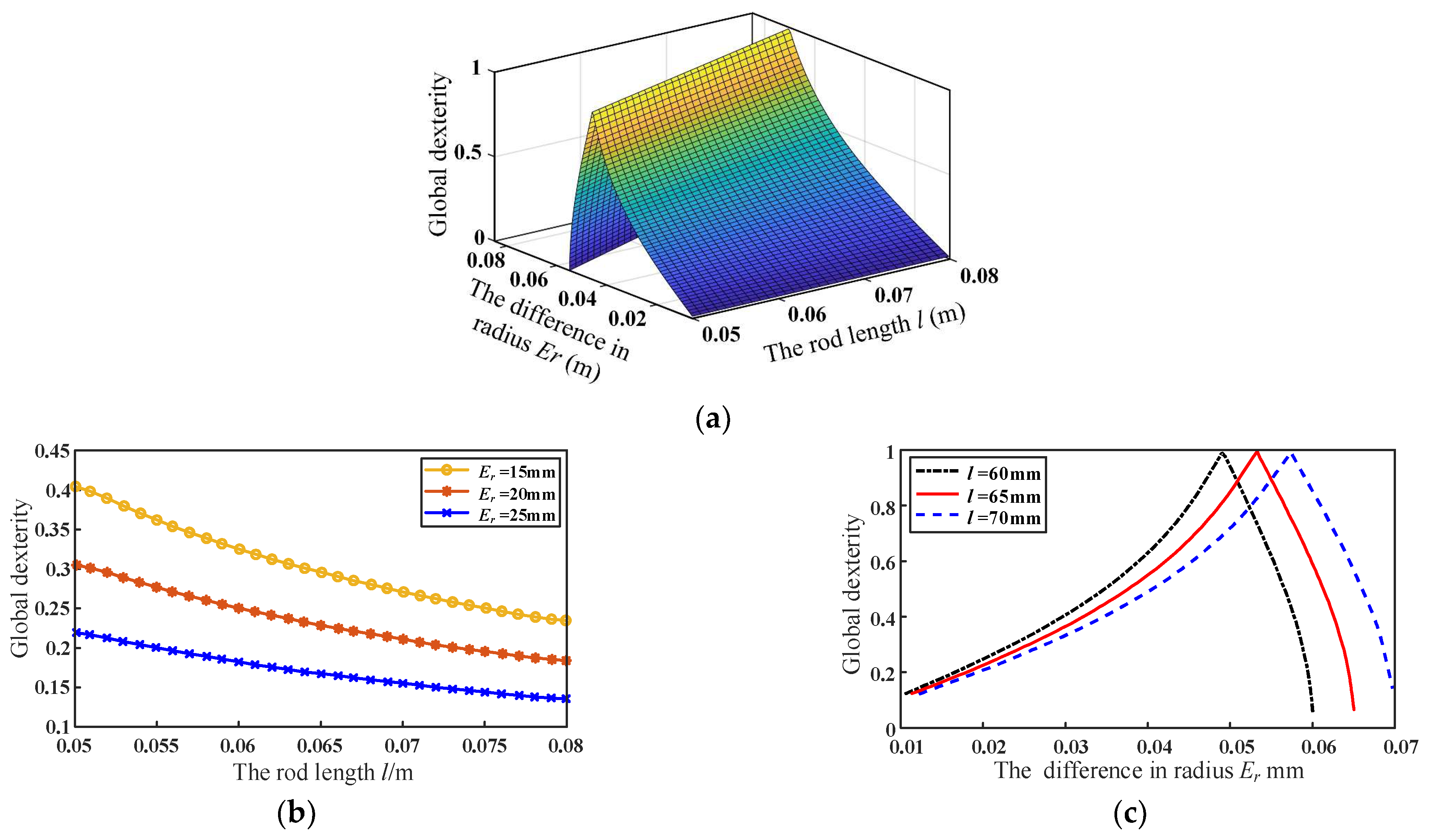
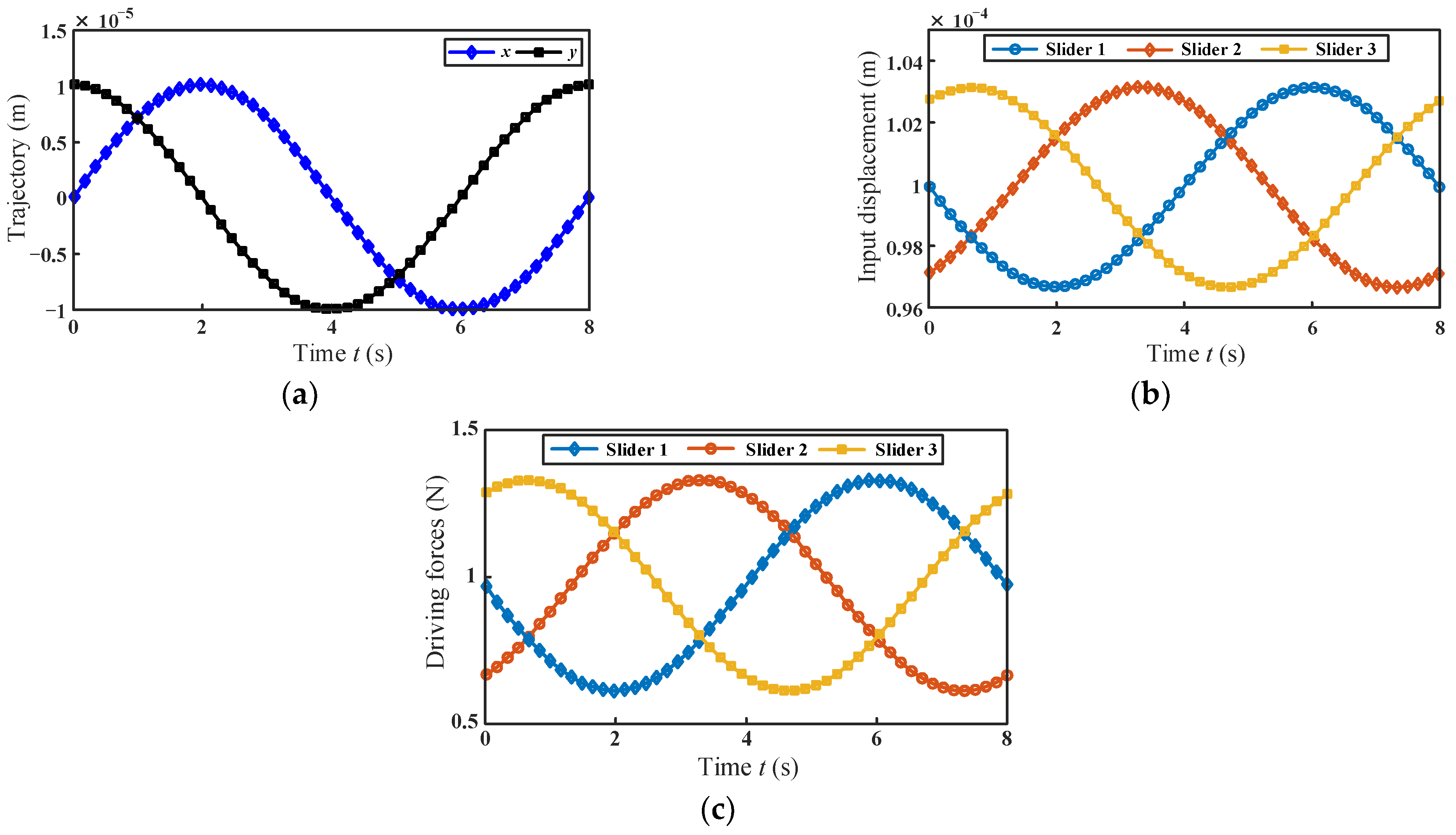
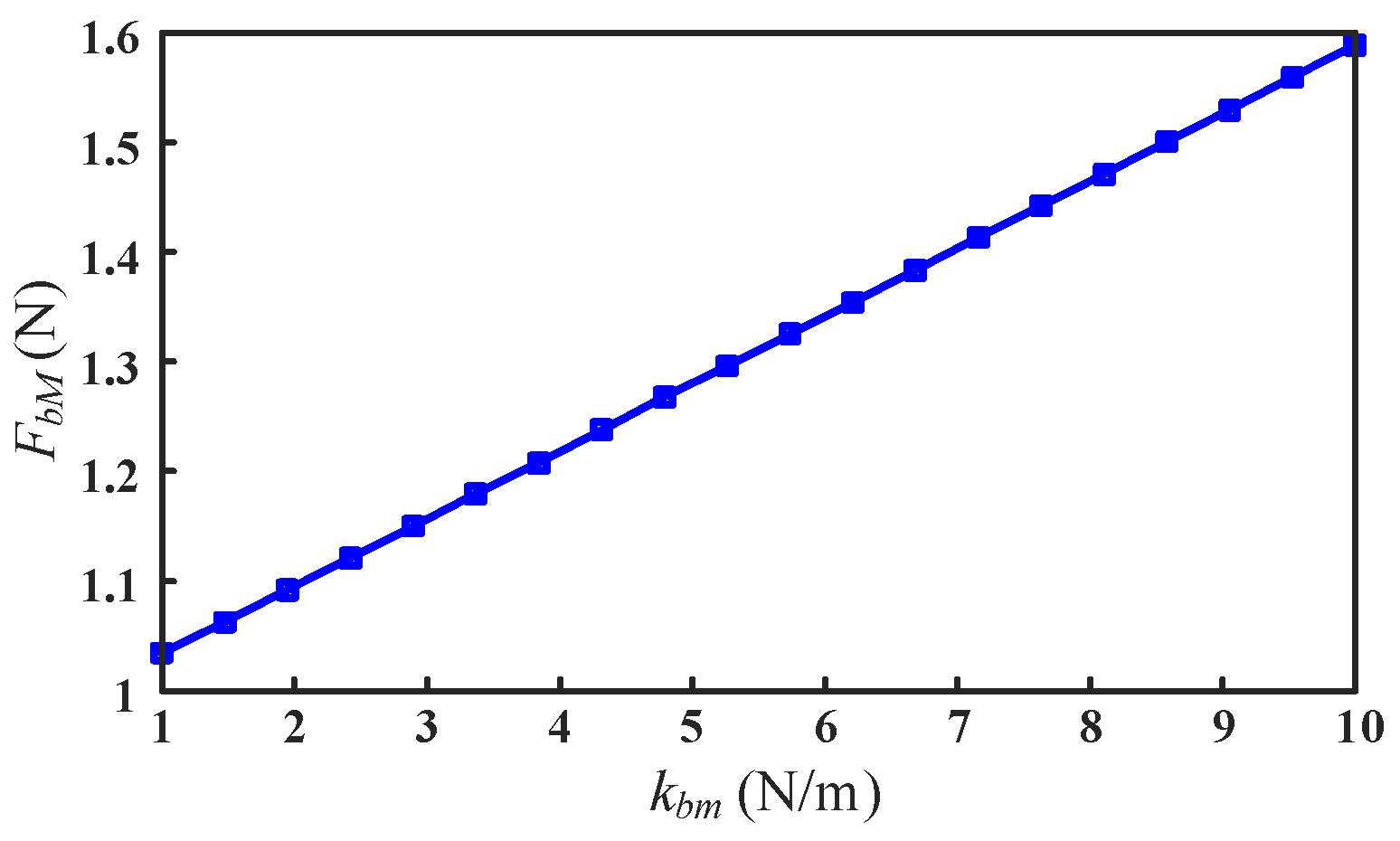
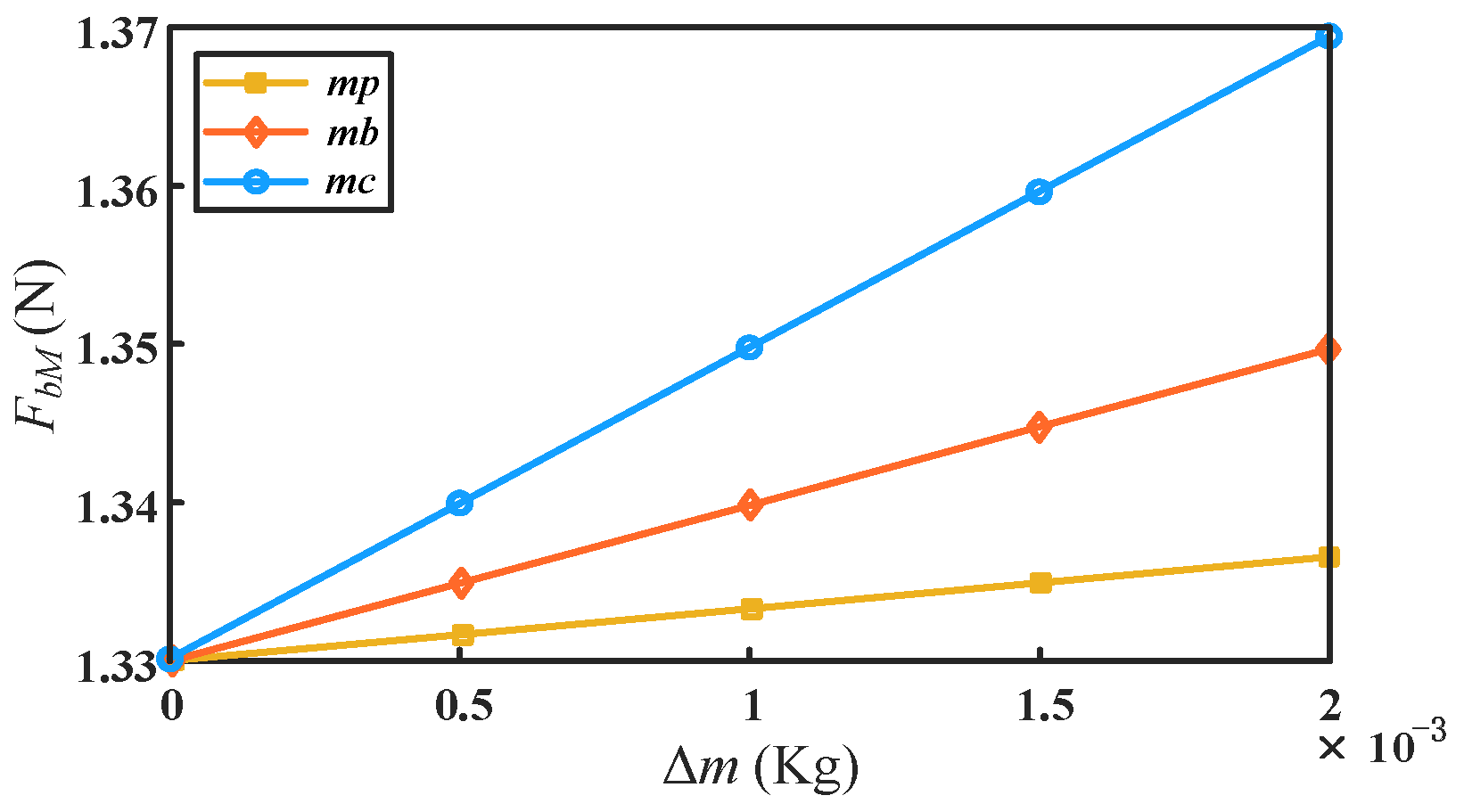


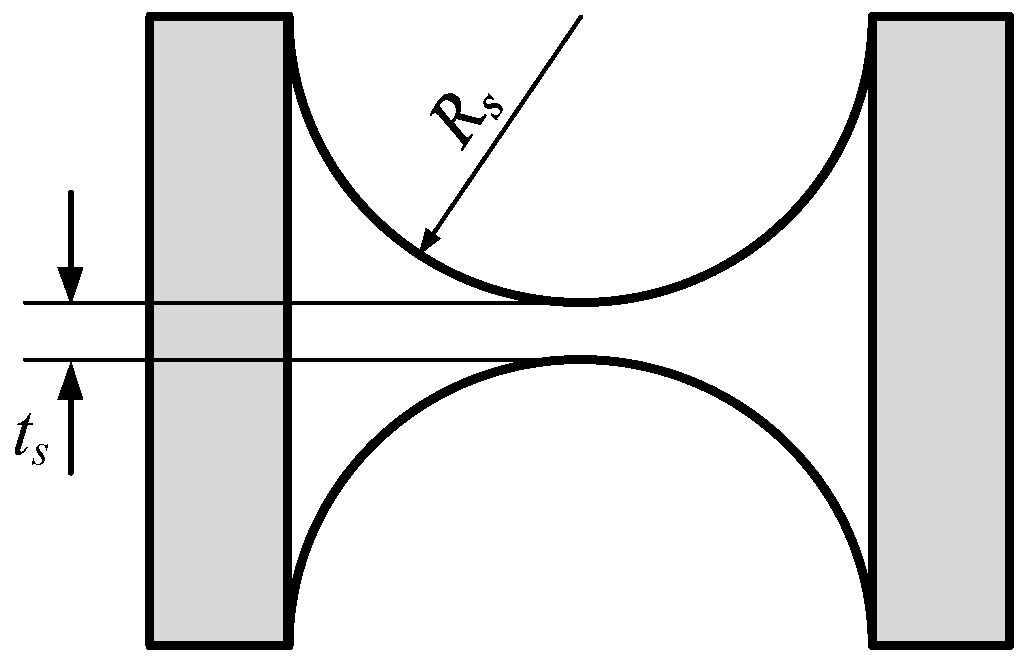
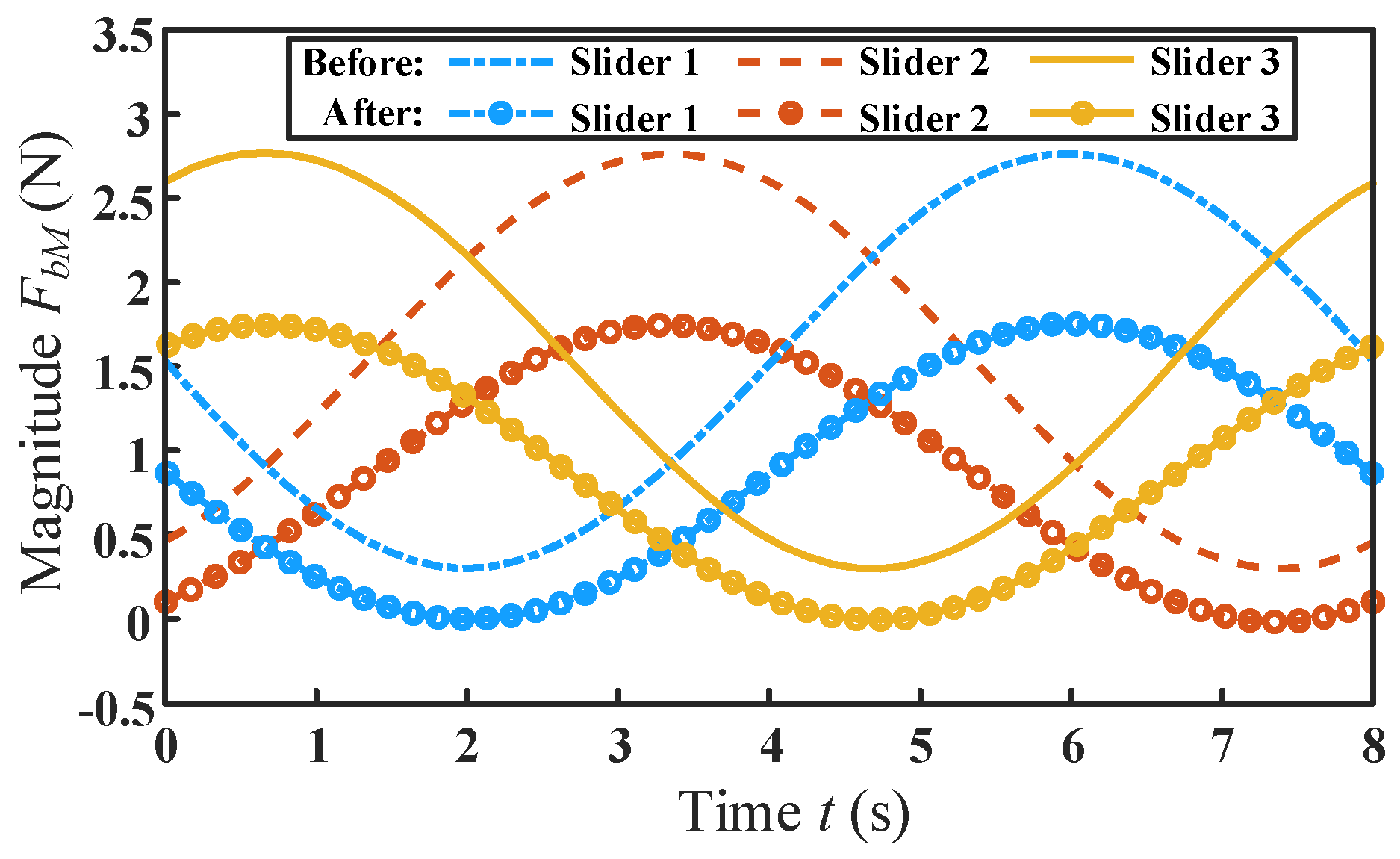

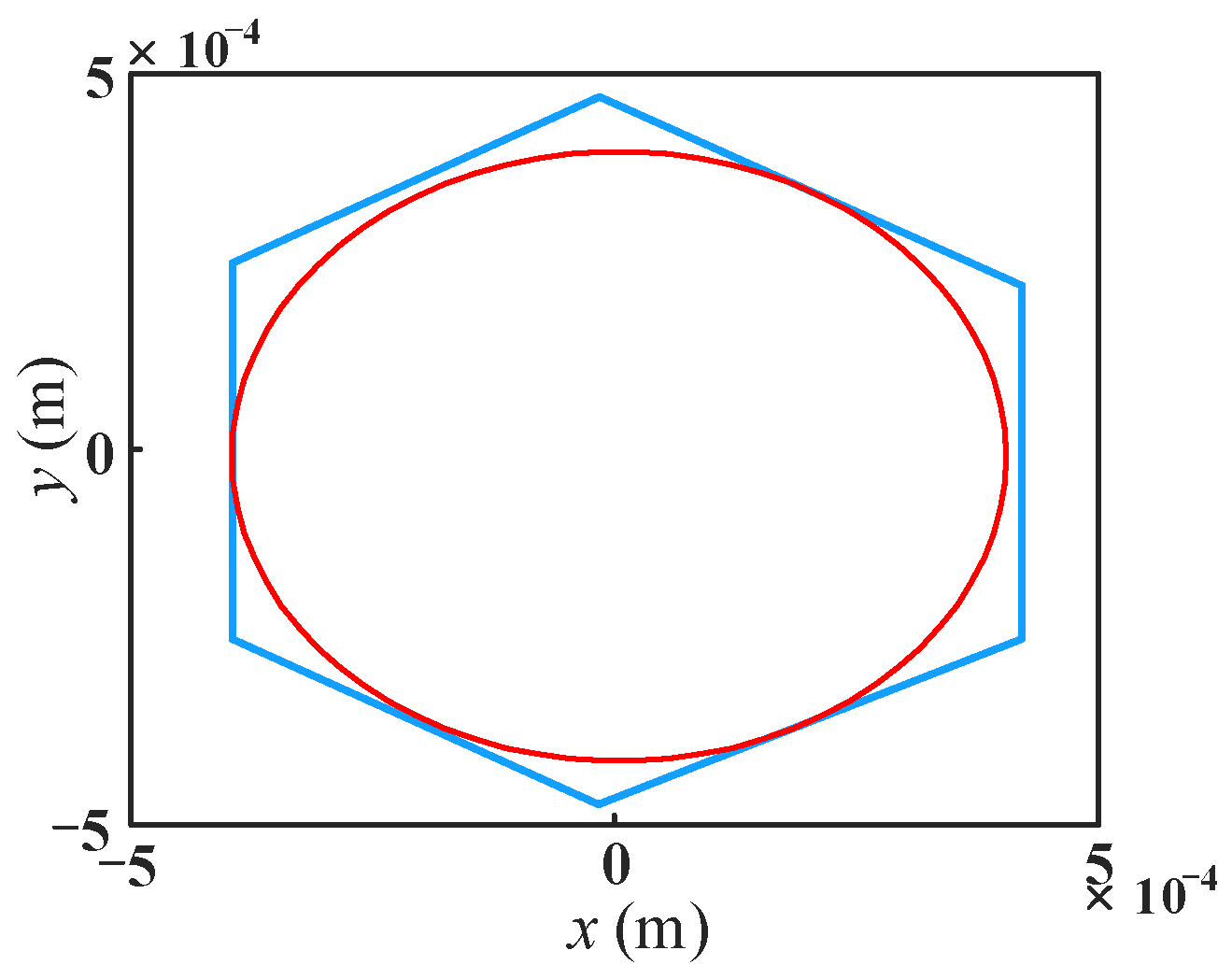
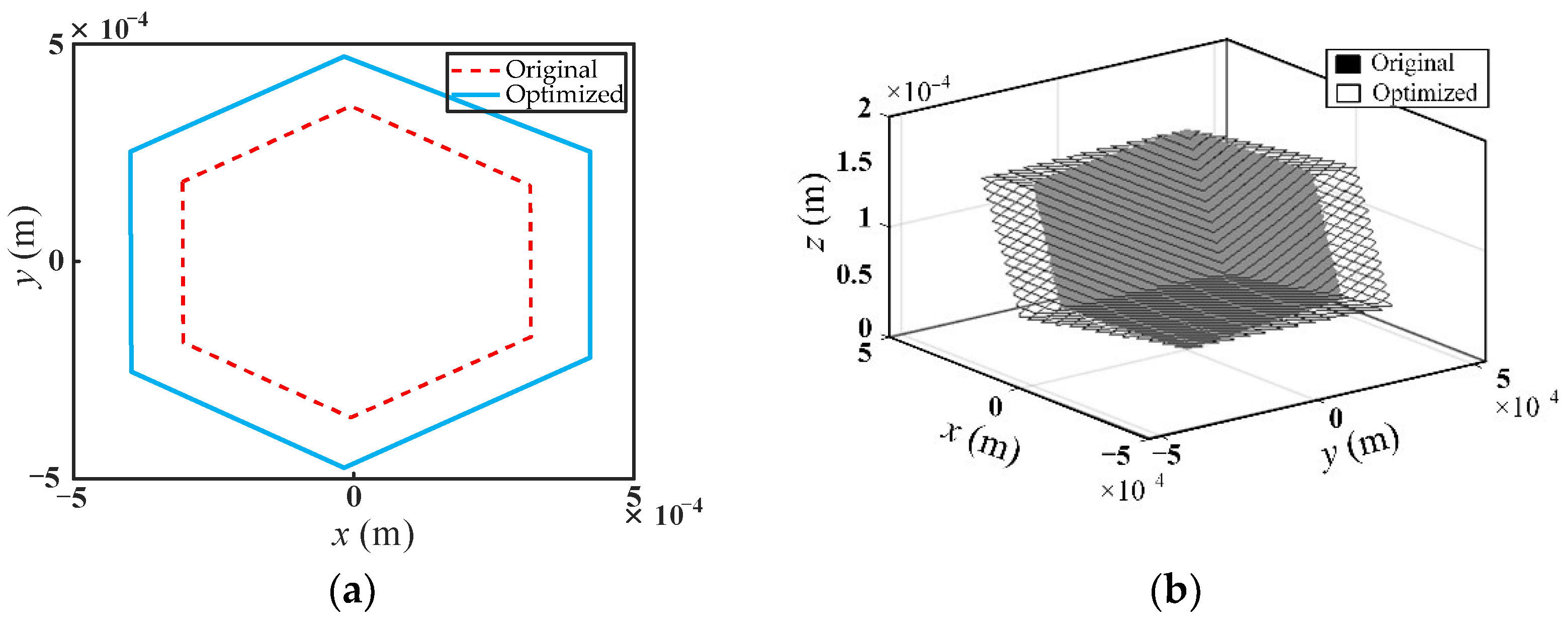
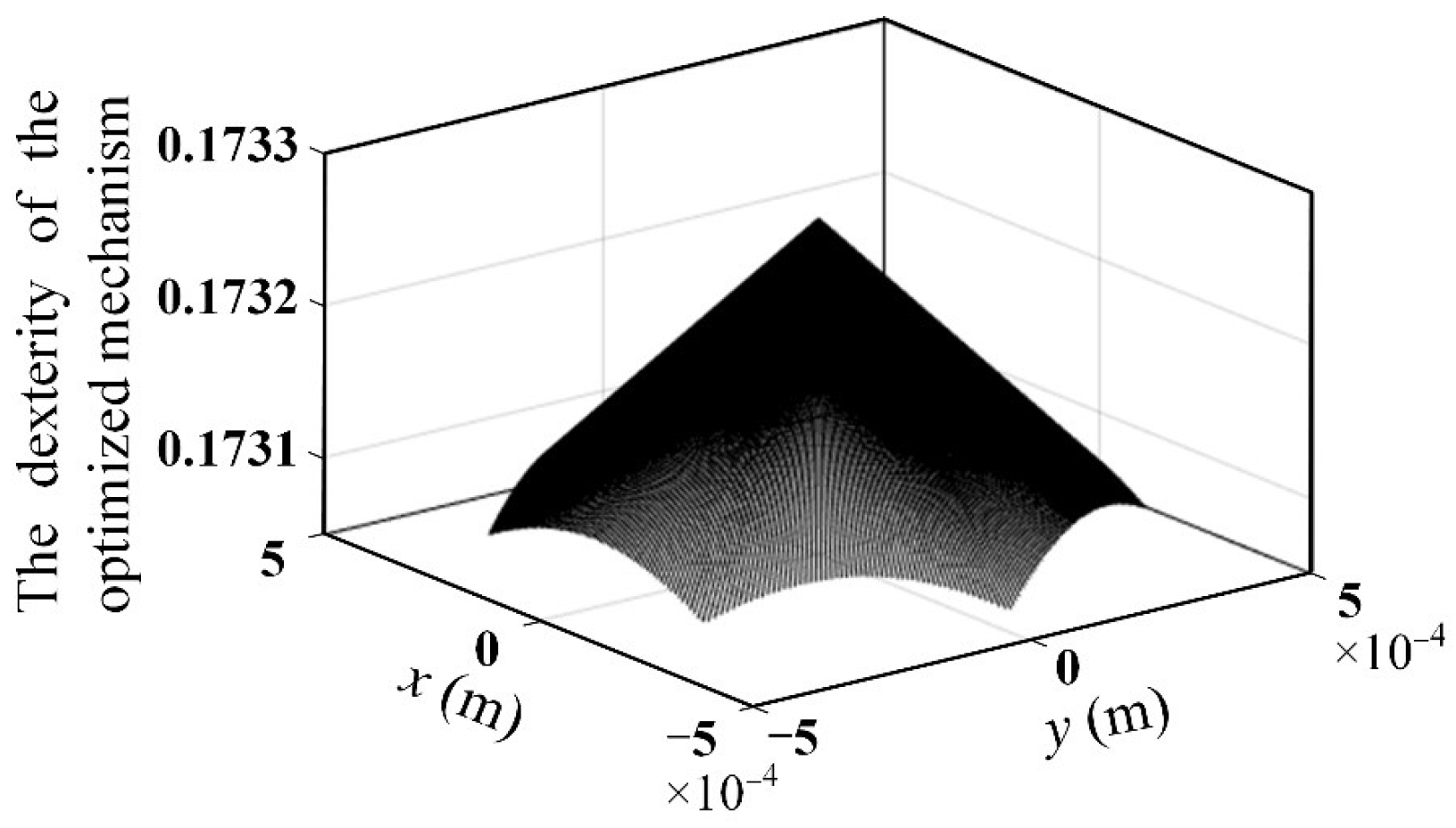
| Parameter | Value | Parameter | Value |
|---|---|---|---|
| rp (mm) | 25 | θl (°) | 60 |
| ra (mm) | 45 | E (Gpa) | 200 |
| l (mm) | 65 | ν | 0.3 |
| ts (mm) | 1 | ρ (g/cm3) | 7.85 |
| Rs (mm) | 2.5 |
| The Weight Factors α | Structural Parameters of Flexure Spherical Hinge (mm) | Mass (kg) | The Bending Stiffness of the Hinge (N/m) | Maximum Absolute Value of Driving Force FbM (N) | |
|---|---|---|---|---|---|
| ts | Rs | ||||
| 0.1 | 0.8 | 1.054 | 0.1310 | 4.744 | 1.8397 |
| 0.2 | 0.8 | 1.584 | 0.1379 | 3.788 | 1.7304 |
| 0.3 | 0.8 | 2.073 | 0.1449 | 3.279 | 1.7303 |
| 0.4 | 0.8 | 2.292 | 0.1482 | 3.109 | 1.7481 |
| 0.5 | 0.8 | 2.294 | 0.1483 | 3.107 | 1.7483 |
| 0.6 | 0.8 | 2.294 | 0.1483 | 3.107 | 1.7483 |
| 0.7 | 0.8 | 2.294 | 0.1483 | 3.107 | 1.7483 |
| 0.8 | 0.8 | 2.294 | 0.1483 | 3.107 | 1.7483 |
| 0.9 | 0.8 | 2.294 | 0.1483 | 3.107 | 1.7483 |
| The Weight Factors α | Structural Parameters of Flexure Spherical Hinge (mm) | Mass (kg) | The Bending Stiffness of the Hinge (N/m) | Maximum Absolute Value of Driving Force FbM (N) | |
|---|---|---|---|---|---|
| ts | Rs | ||||
| 0.21 | 0.8 | 1.633 | 0.1385 | 3.726 | 1.7272 |
| 0.22 | 0.8 | 1.682 | 0.1379 | 3.788 | 1.7249 |
| 0.23 | 0.8 | 1.731 | 0.1399 | 3.611 | 1.7233 |
| 0.24 | 0.8 | 1.781 | 0.1406 | 3.556 | 1.7225 |
| 0.25 | 0.8 | 1.829 | 0.1406 | 3.557 | 1.7223 |
| 0.26 | 0.8 | 1.878 | 0.1420 | 3.456 | 1.7228 |
| 0.27 | 0.8 | 1.926 | 0.1427 | 3.410 | 1.7238 |
| 0.28 | 0.8 | 1.976 | 0.1434 | 3.363 | 1.7255 |
| 0.29 | 0.8 | 2.024 | 0.1441 | 3.321 | 1.7276 |
| Parameters | Before Optimization | After Optimization |
|---|---|---|
| Structural parameter (mm) | ts = 1, Rs = 2.5 | ts = 0.8, Rs = 1.829 |
| Total mass (kg) | 0.1534 | 0.1406 |
| Bending stiffness of hinge kbm (N/m) | 6.5276 | 3.557 |
| Ultimate angular displacement (°) | 2.625 | 2.4739 |
| Driving force FbM (N) | 2.6329 | 1.7223 |
| Natural frequency (Hz) | 75.67 | 57.54 |
| Parameters | Before Optimization | After Optimization |
|---|---|---|
| Inscribed circle radius (μm) | 307 | 400 |
| Scale parameters (mm) | l = 65, ra = 45 | l = 50, ra = 36.92 |
| Volume of workspace | Original | ↑ 31.93% |
| Global dexterity | 0.2287 | 0.173 |
| Natural frequency (Hz) | 56.16 | 73.61 |
Publisher’s Note: MDPI stays neutral with regard to jurisdictional claims in published maps and institutional affiliations. |
© 2022 by the authors. Licensee MDPI, Basel, Switzerland. This article is an open access article distributed under the terms and conditions of the Creative Commons Attribution (CC BY) license (https://creativecommons.org/licenses/by/4.0/).
Share and Cite
Ren, J.; Li, Q.; Wu, H.; Cao, Q. Optimal Design for 3-PSS Flexible Parallel Micromanipulator Based on Kinematic and Dynamic Characteristics. Micromachines 2022, 13, 1457. https://doi.org/10.3390/mi13091457
Ren J, Li Q, Wu H, Cao Q. Optimal Design for 3-PSS Flexible Parallel Micromanipulator Based on Kinematic and Dynamic Characteristics. Micromachines. 2022; 13(9):1457. https://doi.org/10.3390/mi13091457
Chicago/Turabian StyleRen, Jun, Qiliang Li, Hanhai Wu, and Qiuyu Cao. 2022. "Optimal Design for 3-PSS Flexible Parallel Micromanipulator Based on Kinematic and Dynamic Characteristics" Micromachines 13, no. 9: 1457. https://doi.org/10.3390/mi13091457
APA StyleRen, J., Li, Q., Wu, H., & Cao, Q. (2022). Optimal Design for 3-PSS Flexible Parallel Micromanipulator Based on Kinematic and Dynamic Characteristics. Micromachines, 13(9), 1457. https://doi.org/10.3390/mi13091457





